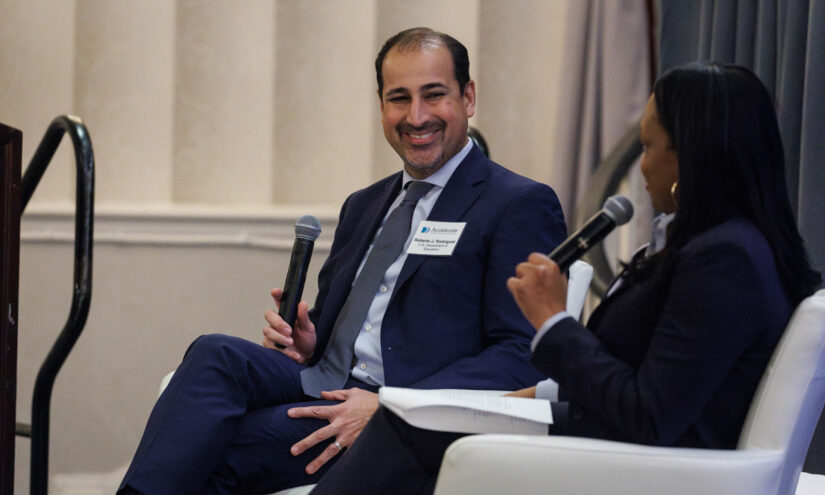As relief funds expire, Harvard’s Kane says ‘whole generation’ still needs help
Linda Jacobson | February 12, 2024
Your donation will help us produce journalism like this. Please give today.

Harvard University researcher Tom Kane stood before a captive audience at Washington’s Omni Shoreham hotel last Wednesday, just hours after dropping the report everyone was talking about.
Offering the best look yet at students’ recovery from pandemic learning loss, the report showed that students actually made impressive academic gains last school year. But achievement gaps grew wider during the pandemic, and students in some high-poverty districts performed worse than they did before COVID.
“There’s a whole generation of kids, especially in poor districts, that are half a grade level or more behind still and are going to need extra help,” he said.
The crowd, composed of some of the nation’s top tutoring providers and researchers, wondered what they should do next.
His answer satisfied few. Despite the high stakes and the imminent end of federal relief funding, many schools still don’t know which interventions are working. As states and districts rushed to hire tutors and sign contracts, many failed to record which programs helped students the most.
“It is amazing that the systems that we entrust with managing our own children’s learning are terrible at learning themselves,” he bluntly told attendees at the event, organized by Accelerate, an organization that works to scale high-dosage tutoring. “It is so frustrating to hear those questions being asked now when the federal dollars are about to run out.”
Those dollars — $122 billion from the 2021 American Rescue Plan — expire at the end of September. At a time when the research shows many students are still far behind, the U.S. Department of Education is giving states a chance to spread out use of remaining funds until March 2026, especially if they use it to reduce absenteeism, provide intensive tutoring and extend learning time. But Kane said states should also seize the opportunity to better track which recovery strategies are helping students the most.
“I don’t mean to complain about water under the bridge, but let’s try to think of this going forward,” he said.
Education department officials say they’re trying. Starting this spring, all districts will have to provide more details on how the funds were spent. Previously, districts had to show whether they provided summer learning, afterschool programs or tutoring to address learning loss. Now they’ll need to report how much they’ve spent on those areas as well.
Districts also have to report how many students participated in high-dosage tutoring and “evidence-based” summer and afterschool programs and whether they came from traditionally disadvantaged groups such as low-income students, English learners or students with disabilities. And if states want to apply for an extension, they’ll need to submit a letter explaining how they would use the funds to reach the neediest students.
“We do want to know more from states and from districts about how they’re putting these dollars to use to support academic recovery,” Roberto Rodriquez, an assistant secretary at the U.S. Department of Education, told LA School Report. “Are we investing in some of these evidence-driven strategies?”

‘Students won’t have caught up’
Kane cited a previous lack of “federal leadership” on collecting such information and said states were hesitant to impose additional requirements not mandated by the 2021 relief fund law.
“States were in the back seat, watching districts make decisions on how to spend the money. They’ve been slow to get in the front seat,” he told LA School Report. He urged federal officials to “publicly challenge states” to continue recovery efforts. “As the recovery dollars are tapering down, it’s clear students won’t have caught up.”
According to federal data, states had about $53 billion remaining in American Rescue Plan funds last November. Rodriquez said the department has received a lot of interest from states on extensions, but no applications yet.
Even if they don’t get more time to spend the funds, districts still have this summer to focus on students who are furthest behind, Kane said. He recommended that states require districts to inform parents whether their children are below grade level in reading and math and then serve all who sign up for summer school.
Most parents are “fairly removed” from discussions about relief funds, said Bibb Hubbard, founder and president of Learning Heroes, a nonprofit that explains achievement data to parents. But she said they shouldn’t be misinformed about whether their children are far behind.
“They often think that’s someone else’s child, not their own,” she said. The new recovery data, she said, reinforces how important it is that “parents know exactly where their children are academically at the end of the school year.”
The Harvard study was conducted in partnership with Stanford University sociologist Sean Reardon. The district-level results show that students made up a third of the learning they lost in math and a quarter of the loss in reading. This was more than students typically gained in a year prior to the pandemic. Alabama, for example, saw the most improvement in math and was the only state to exceed pre-pandemic achievement levels.
Three states rebounded past 2019 performance in reading: Illinois, Louisiana and Mississippi. Black students made more progress between 2022 and 2023 than white and Hispanic students, but the achievement gap between white and Black students was still larger last year than it was before the pandemic.
Despite the growth, most students performed below 2019 achievement levels, especially in high-poverty districts. In six states, the gap between high- and low-poverty districts grew wider in reading between 2019 and 2023.
Virginia was one.
“We were struggling to catch up, much less get a step ahead,” state Superintendent Lisa Coons told LA School Report. She added that officials “expect persistent learning loss.”
To supplement declining relief funds, the state added $418 million last fall for tutoring, improving literacy and reducing chronic absenteeism. While she said her state would likely ask for an extension, she wants districts to move away from a “buffet” of initiatives and choose programs that fit the effective models outlined in a new state guide for districts. The resource provides details on how to choose students for tutoring and fit sessions into the school schedule.
“We need to continue to prune,” she said, “and work on the things that we know are showing results for our students.”
This article was published in partnership with The 74. Sign up for The 74’s newsletter here.